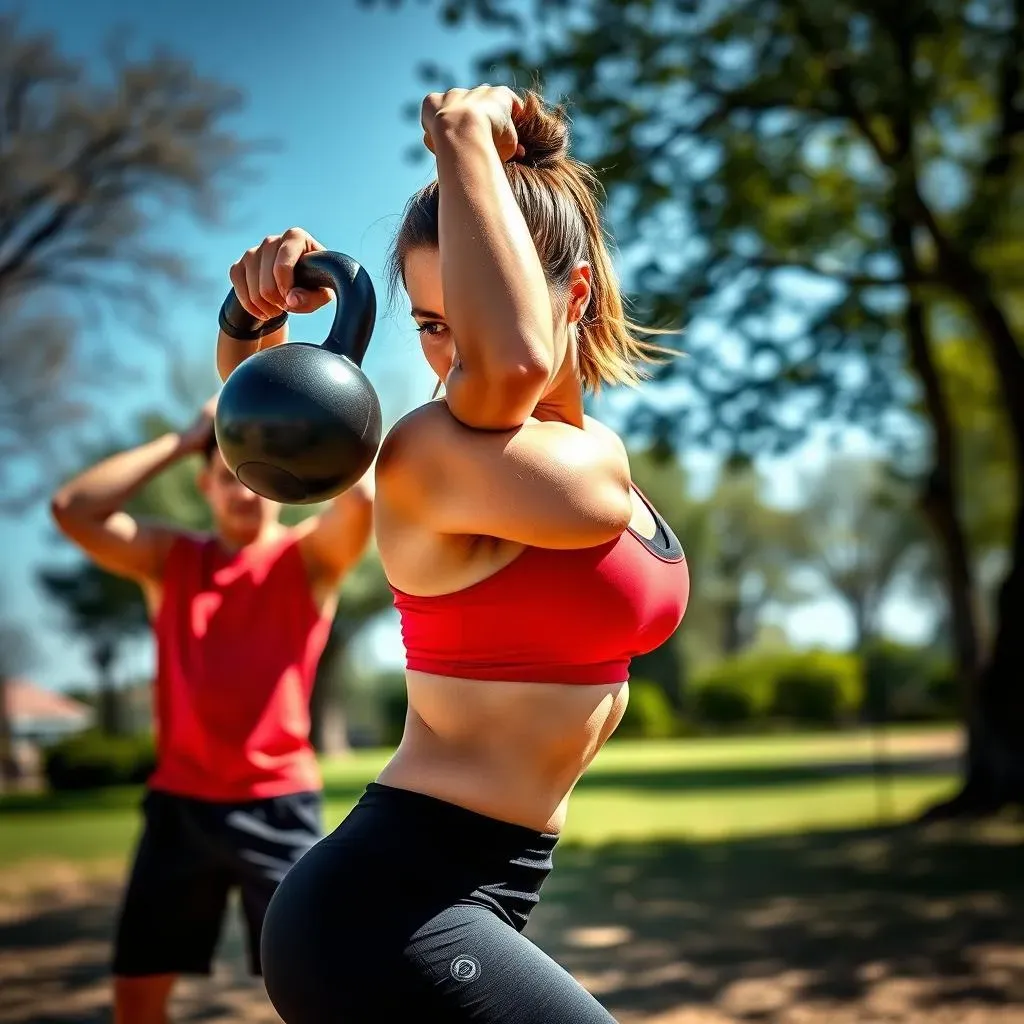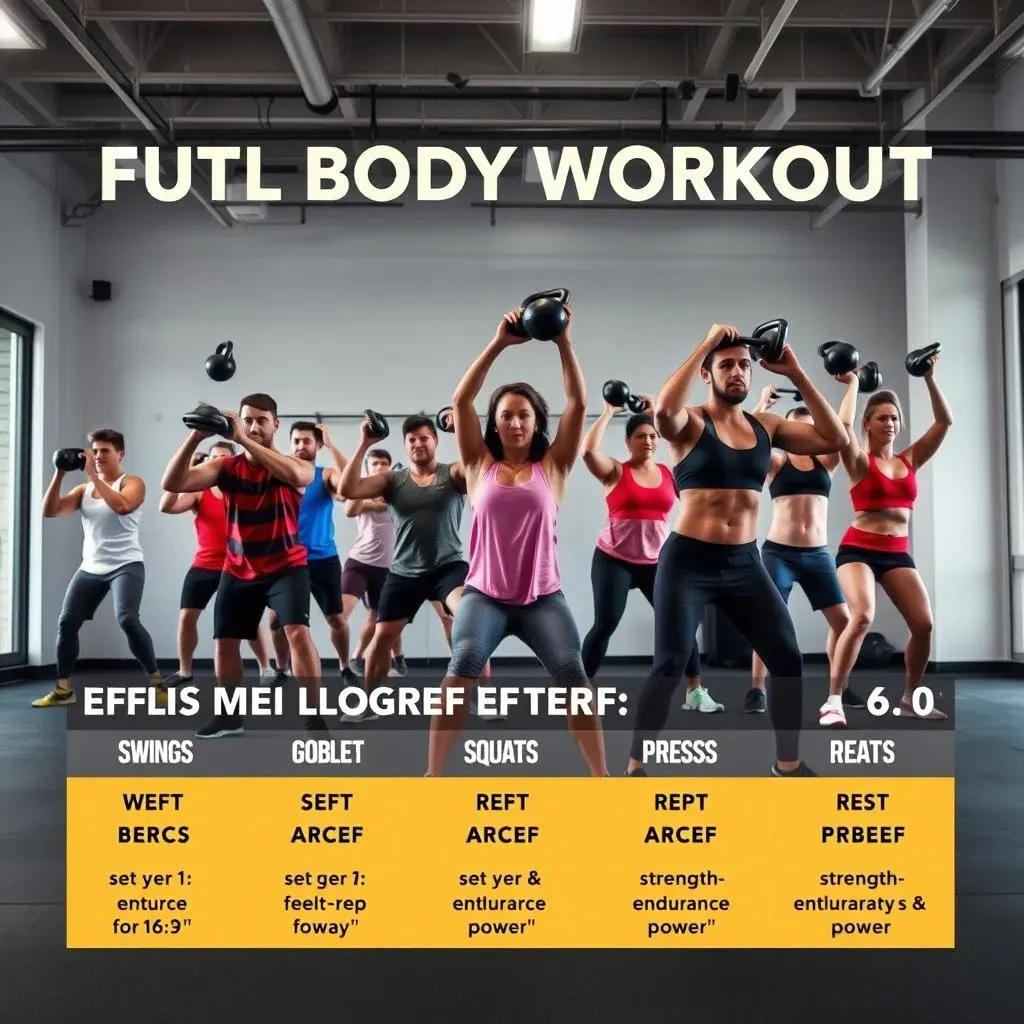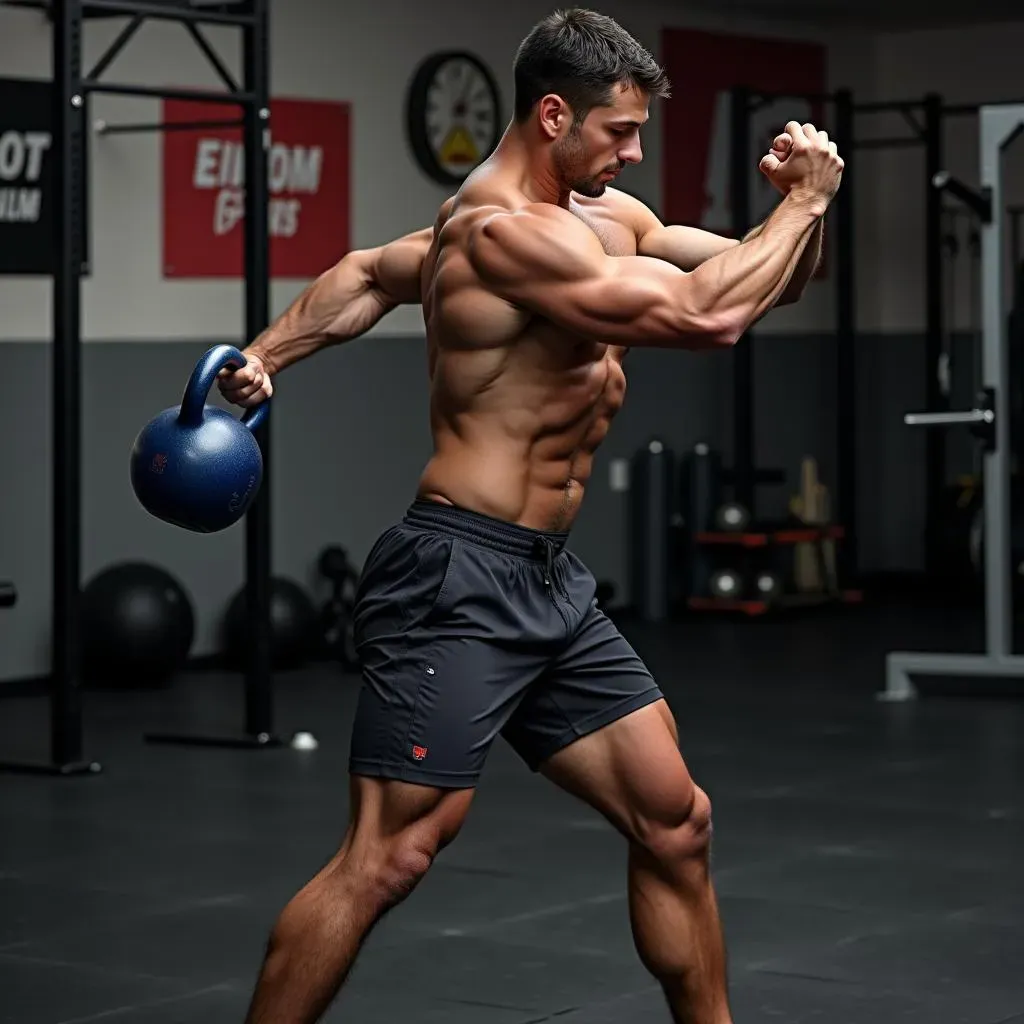Table of Contents
Ready to ditch the boring gym routines and unlock a powerhouse of strength? Then it's time to dive into the world of full body kettlebell workouts. These aren't your grandma's gentle exercises; we're talking dynamic movements that torch calories, build serious muscle, and boost your endurance, all while keeping things interesting. This isn't just about lifting weights; it's about functional fitness that translates to real-world strength and agility. Forget isolating muscles – kettlebells engage your entire body, forcing you to work harder and smarter.
Why Full Body Kettlebell Workouts are a Game Changer

Why Full Body Kettlebell Workouts are a Game Changer
Efficiency Redefined: The Time-Saving Superstar
Let's be honest, who has hours to spend at the gym these days? Full body kettlebell workouts are a godsend for the time-crunched. Because they engage multiple muscle groups simultaneously, you're getting a full-body blast in a fraction of the time compared to traditional isolation exercises. Think about it: squats, deadlifts, and presses all rolled into one dynamic movement. You're not just building strength; you're also improving your cardiovascular fitness and burning a ton of calories. It's like hitting three birds with one seriously powerful stone.
I remember when I first switched to kettlebells, I was skeptical. Could these cannonball-shaped things really replace my carefully planned weightlifting routine? But after just a few weeks, I was hooked. I was spending less time in the gym, feeling stronger, and seeing better results. Plus, the variety of movements kept things from getting stale. It's a win-win.
Beyond Strength: Unlocking Functional Fitness
Kettlebells aren't just about building muscle; they're about building functional strength. This means strength that translates to everyday activities, from carrying groceries to playing with your kids. The unique offset weight of a kettlebell forces your body to stabilize and control the movement, engaging your core and improving your balance. You're not just lifting weight; you're learning to move your body more efficiently and effectively.
Think of a kettlebell swing. It's not just an arm exercise; it's a full-body movement that engages your glutes, hamstrings, core, and back. You're building explosive power, improving your posture, and strengthening your entire posterior chain. This translates to better performance in sports, reduced risk of injury, and a greater sense of overall athleticism.
Essential Kettlebell Exercises for a Full Body Workout

Essential Kettlebell Exercises for a Full Body Workout
The King: Kettlebell Swings
If there's one exercise that defines kettlebell training, it's the swing. This explosive movement targets your posterior chain – glutes, hamstrings, and back – while also engaging your core and shoulders. The kettlebell swing isn't just about swinging a weight; it's about generating power from your hips and using that power to propel the kettlebell forward. Master the swing, and you've unlocked the key to unlocking serious strength and power.
I always tell people to think of the swing as a hip hinge, not a squat. You're not lifting the kettlebell with your arms; you're using your hips to drive the movement. Keep your back straight, your core engaged, and your eyes focused forward. And remember, it's a swing, not a lift. Let the momentum of the kettlebell do the work.
The Squat Variation: Goblet Squats
The goblet squat is a fantastic variation of the traditional squat that's especially beneficial for kettlebell training. Holding the kettlebell close to your chest in a "goblet" position forces you to maintain an upright posture and engage your core. This not only improves your squat form but also strengthens your upper back and shoulders. The goblet squat is a great way to build lower body strength and improve your overall stability.
What I love about the goblet squat is how accessible it is. Even beginners can usually perform it with good form. It's also a great way to warm up before a heavier workout or to add some extra volume to your leg day. Just grab a kettlebell, hold it close to your chest, and squat down as low as you can while maintaining good form. You'll feel the burn in your quads, glutes, and core.
The Total Package: Turkish Get-Ups
If you want a full-body exercise that challenges your strength, mobility, and coordination, look no further than the Turkish get-up. This complex movement involves transitioning from lying on the ground to standing up while holding a kettlebell overhead. It's a slow, deliberate exercise that requires focus, control, and a whole lot of grit. The Turkish get-up not only builds strength but also improves your shoulder stability, core strength, and overall body awareness.
I'm not going to lie, the Turkish get-up can be intimidating at first. It's a complex movement with a lot of steps. But once you break it down and practice each step individually, it becomes much more manageable. Start with a light weight and focus on maintaining good form throughout the entire movement. And don't be afraid to ask a qualified coach for guidance. The Turkish get-up is a challenging exercise, but it's also incredibly rewarding.
Exercise | Target Muscles | Benefits |
|---|---|---|
Kettlebell Swings | Glutes, Hamstrings, Back, Core | Explosive power, cardiovascular fitness, calorie burning |
Goblet Squats | Quads, Glutes, Core, Upper Back | Lower body strength, improved squat form, stability |
Turkish Get-Ups | Full Body | Strength, mobility, coordination, shoulder stability |
Crafting Your Own Full Body Kettlebell Workout Routine

Crafting Your Own Full Body Kettlebell Workout Routine
Selecting the Right Exercises: A Balanced Approach
so you're ready to build your own full body kettlebell workout routine. Awesome! The key here is balance. You want to hit all the major muscle groups – legs, glutes, back, chest, shoulders, and core – with a mix of exercises that challenge your strength, power, and endurance. Think about incorporating a squat variation (like goblet squats), a hinge movement (like kettlebell swings or Romanian deadlifts), a pressing exercise (like a kettlebell press or push-ups), a pulling exercise (like rows), and a core exercise (like planks or Russian twists). This ensures you're getting a well-rounded workout that targets all your muscles and improves your overall fitness.
When I'm designing a kettlebell workout, I like to start by choosing 4-5 exercises that cover all the major movement patterns. Then, I'll structure the workout in a way that maximizes efficiency and minimizes fatigue. For example, I might pair a strength exercise (like goblet squats) with a power exercise (like kettlebell swings) in a superset. This allows you to work different muscle groups back-to-back, keeping your heart rate up and burning more calories. And don't forget to warm up properly before each workout and cool down afterward. This will help prevent injuries and improve your recovery.
Structuring Your Workout: Sets, Reps, and Rest
Now that you've chosen your exercises, it's time to figure out how many sets, reps, and rest periods you should do. This will depend on your fitness level and your goals. If you're a beginner, start with 2-3 sets of 10-12 reps for each exercise. As you get stronger, you can increase the number of sets or reps, or you can try using a heavier kettlebell. For rest periods, aim for 30-60 seconds between sets. This will give your muscles enough time to recover without letting your heart rate drop too much.
If your goal is to build strength, focus on using heavier weights and lower reps (6-8 reps per set). For endurance, use lighter weights and higher reps (15-20 reps per set). And for power, focus on explosive movements with moderate weights and moderate reps (8-10 reps per set). Experiment with different set and rep schemes to see what works best for you. And don't be afraid to change things up every few weeks to keep your body guessing.
Goal | Sets | Reps | Rest |
|---|---|---|---|
Strength | 3-5 | 6-8 | 60-90 seconds |
Endurance | 2-3 | 15-20 | 30-45 seconds |
Power | 3-4 | 8-10 | 45-60 seconds |
Full Body Kettlebell Workout: Form, Safety, and Progression

Full Body Kettlebell Workout: Form, Safety, and Progression
Mastering the Fundamentals: Form is King
Alright, let's talk about the nitty-gritty of full body kettlebell workout: form. I can't stress this enough – proper form is non-negotiable. It's not just about preventing injuries; it's also about maximizing the effectiveness of your workouts. Think of it like building a house: if the foundation is weak, the whole structure will crumble. The same goes for kettlebell training. If your form is sloppy, you're not only putting yourself at risk of injury, but you're also cheating yourself out of the full benefits of the exercises.
I always recommend starting with lighter weights and focusing on mastering the fundamental movements before progressing to heavier weights or more complex exercises. Break down each exercise into its component parts and practice each part individually. For example, with the kettlebell swing, focus on the hip hinge, the core engagement, and the arm position. Once you've mastered each part, put it all together. And don't be afraid to ask a qualified coach for feedback. A fresh pair of eyes can often spot subtle errors in your form that you might not notice yourself.
Listen to Your Body: Avoiding the Overtraining Trap
So, you are crushing your full body kettlebell workout, feeling great, and seeing results. Awesome! But it's crucial to remember that recovery is just as important as training. Overtraining can lead to fatigue, injury, and burnout. It's like driving a car with the gas pedal floored all the time – eventually, the engine will overheat. The same goes for your body. You need to give it time to rest and recover so it can rebuild and get stronger.
I always advise listening to your body and taking rest days when you need them. Don't be afraid to scale back your workouts if you're feeling tired or sore. And make sure you're getting enough sleep, eating a healthy diet, and staying hydrated. These are all essential for recovery. Also, consider incorporating active recovery into your routine, such as light cardio or stretching. This can help improve blood flow and reduce muscle soreness. Remember, it's a marathon, not a sprint. Consistency is key, but so is listening to your body and giving it the rest it needs.
Symptom | Possible Cause | Solution |
|---|---|---|
Persistent Muscle Soreness | Overtraining, inadequate recovery | Rest, active recovery, massage |
Decreased Performance | Overtraining, fatigue | Reduce training volume, increase rest |
Sleep Disturbances | Stress, overtraining | Improve sleep hygiene, reduce stress |
Beyond the Basics: Level Up Your Full Body Kettlebell Training

Beyond the Basics: Level Up Your Full Body Kettlebell Training
Unlocking Advanced Kettlebell Techniques
So, you've mastered the basics of full body kettlebell training – swings, squats, get-ups – and you're feeling like a total badass. What's next? It's time to explore the world of advanced kettlebell techniques. These aren't just fancy exercises; they're tools for pushing your strength, power, and coordination to the next level. Think about movements like snatches, cleans, jerks, and windmills. These exercises require a high level of skill and control, but they also offer incredible benefits.
When you're ready to tackle advanced kettlebell techniques, I highly recommend seeking guidance from a qualified coach. These movements are complex, and proper form is crucial. A coach can help you break down each exercise into its component parts, identify any weaknesses in your technique, and provide personalized feedback. Don't be afraid to start slow and focus on mastering the fundamentals before progressing to more challenging variations. And remember, it's not about lifting the heaviest weight; it's about moving well and challenging your body in new ways.
Programming for Peak Performance
You've got the moves down, but how do you structure your full body kettlebell workout to maximize your results? That's where programming comes in. Programming is the art and science of designing a workout routine that's tailored to your specific goals and needs. It involves considering factors like exercise selection, set and rep schemes, rest periods, and training frequency.
I always tell people to think of their workout routine as a puzzle. Each exercise is a piece of the puzzle, and the way you arrange those pieces will determine the final picture. For example, if your goal is to build strength, you'll want to focus on using heavier weights and lower reps. If your goal is to improve endurance, you'll want to use lighter weights and higher reps. And if your goal is to increase power, you'll want to focus on explosive movements with moderate weights and moderate reps. Experiment with different programming strategies to see what works best for you. And don't be afraid to seek guidance from a qualified coach or trainer. They can help you design a workout routine that's safe, effective, and tailored to your individual needs.
Programming Variable | Strength | Endurance | Power |
|---|---|---|---|
Weight | Heavy | Light | Moderate |
Reps | 6-8 | 15-20 | 8-10 |
Sets | 3-5 | 2-3 | 3-4 |
Elevate Your Fitness with Full Body Kettlebell Workouts
Incorporating full body kettlebell workouts into your fitness regimen is more than just a trend; it's a commitment to functional strength, improved endurance, and overall well-being. From mastering the fundamental exercises to crafting personalized routines and prioritizing safety, you're now equipped to harness the transformative power of the kettlebell. Embrace the challenge, stay consistent, and watch as you unlock a new level of fitness and strength. Your journey to a stronger, fitter you starts now – with every swing, squat, and press.